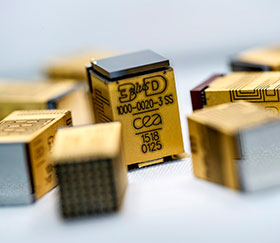

3D Plus has developed, in collaboration with CEA (France), gamma ray detectors for STIX instrument on board the Solar Orbiter. The mission was launched on 10 February 2020 from Cape Canaveral in Florida (USA).
The Solar Orbiter space mission is the result of an international collaboration between ESA and NASA, with the spacecraft being developed by Airbus (France). Solar Orbiter is one of the complementary spacecraft studying the sun at close proximity, as it will join NASA’s Parker Solar Probe launched in 2018 and already engaged in its exploration. Solar Orbiter will operate for years in one of the most hostile regions of the solar system and study the sun up close. For the first time, the mission will provide high-resolution images of the uncharted sun’s polar regions.
Among the ten instruments composing Solar Orbiter, the Spectrometer/Telescope for Imaging X-rays (STIX) performs hard X-ray imaging spectroscopy of solar flares. It consists of 32 collimators with grids and 32 spectrometer units, called Caliste-SO. The set of these two subsystems will allow the spectro-imaging of solar flares in the field of hard X-rays with a very high level of precision.
The result of a collaboration between 3D Plus and CEA (France), Caliste-SO units are CdTe hybrid detectors. They integrate a 1 cm2 CdTe multi-pixel sensor with a low-noise, low-power analog front-end ASIC and circuits for power supply regulation and filtering.
Based on 3D Plus’ unique technology, the design of Caliste-SO vertically stacked four PCBs, which allowed placing ASICs at close distance to the CdTe crystal, therefore increasing the SNR (signal-to-noise ratio). The instrument reaches a high resolution thanks to the miniaturisation of this sensor, which allowed implementing a matrix of 32 units close together. This design suits STIX spectroscopic requirements allowing both high spectral resolution and high-count rate measurements while perfectly suiting system constraints in terms of volume, mass and power. The STIX instrument also embeds many 3D Plus volatile and non-volatile memory parts (512 Mbit SRAM, 64 Gbit NAND Flash and 8 Mbit EEPROM).
3D Plus has also supplied multiple highly reliable memory modules for several instruments. The Polarimetric and Helioseismic Imager (PHI) includes 3D Plus SRAM, SDRAM and NOR Flash and the Energetic Particle Detector (EPD) embeds the company’s SDRAM and NAND Flash. 3D Plus memories offer the smallest footprint thanks to the high level of miniaturisation, while providing very high densities for electronic designs.
The Extreme Ultraviolet Imager (EUI) instrument integrates 3D Plus high integration and space qualified all-in-one latch-up current limiters (LCL). This is an optimised solution for power line protection for advanced high-performance electronics and memory banks in space applications.
3D Plus is proud to contribute to such challenging mission with ambitious scientific objectives since Solar Orbiter, together with the Parker Solar Probe mission, will allow unprecedented insight into how our parent star works. The mission aims to reveal how the sun creates and controls the heliosphere that surrounds the whole solar system and influences the planets.
| Tel: | +27 11 315 8316 |
| Email: | [email protected] |
| www: | www.asic.co.za |
| Articles: | More information and articles about ASIC Design Services |

© Technews Publishing (Pty) Ltd | All Rights Reserved